Spain and Sweden face off against each other in the Estadio La Cartuja de Sevilla on Monday night in a highly-anticipated game featuring two very interesting sides from a tactical perspective.
Spain, under the guidance of the former Barcelona and Roma manager Luis Enrique, looked really sharp in the qualifying campaign for this summer’s tournament, topping the group with eight wins and two draws from ten matches and going unbeaten. They finished five points ahead of the team in second place, which was Sweden.
Sweden lost just once in their ten games, winning six and drawing three times. However, the one loss suffered was to Spain in a 3-0 defeat at the Santiago Bernabeu in Madrid.
The Blue and Yellow will be looking for vengeance in this match-up and to put an early puncture in the wheels of Spain’s hopes of winning the competition as they currently one of the bookmakers’ favourites.
This article will be a tactical analysis preview of the game between Spain and Sweden in the opening game-week of Euro 2020. It will be an analysis of the tactics employed by both sides as well as where they should look to hurt each other structurally.
Predicted Lineups and formations
Both teams’ lineups are quite difficult to predict considering the constant interchanging of personnel from both Janne Anderson and Enrique. The formations, on the other hand, will not be so difficult to predict and it is likely that Spain will deploy their typical 4-3-3 that can switch to more a 4-2-1-3 during certain phases whilst Sweden will play their conventional 4-4-2 system that they have become so accustomed to playing under Anderson during his five years in charge.
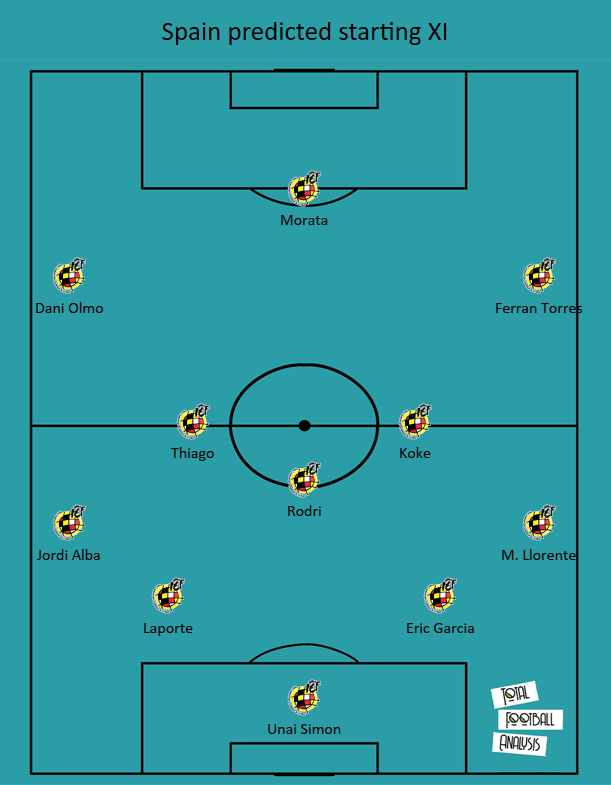
This is likely to be Spain’s starting eleven against Sweden on Monday night, although there could possibly be one or two alterations. Unai Simon has been Enrique’s preferred goalkeeper in net over David de Gea and Robert Sanchez and so will probably get the nod.
The keeper will be protected by a back four comprising of Jordi Alba, Aymeric Laporte, Eric Garcia, and Marcos Llorente. The main questionable option here is Garcia as the right centre-back. Enrique trialled a centre-back pairing of Pau Torres and Laporte in Spain’s recent pre-tournament friendly against Portugal and they managed to keep a clean sheet, so this partnership is just as likely. However, the reason we have decided to go with Garcia is that he is right-footed whereas both Laporte and Torres are left-footed. Having a left-footed centre-back there would make it more difficult for them to open out and play with their stronger, making them easier to press.
The single-pivot position would have been contestable until Sunday afternoon when the news broke that Spanish legend Sergio Busquets had tested positive for COVID-19. By default, Enrique will be forced to start Rodri, although the Manchester City player has had a stellar campaign, winning the Premier League and Carabao Cup as well as reaching the UEFA Champions League final.
The advanced midfielders will be Thiago Alcantara and Koke, flanked by Dani Olmo and Ferran Torres with Alvaro Morata leading the line.
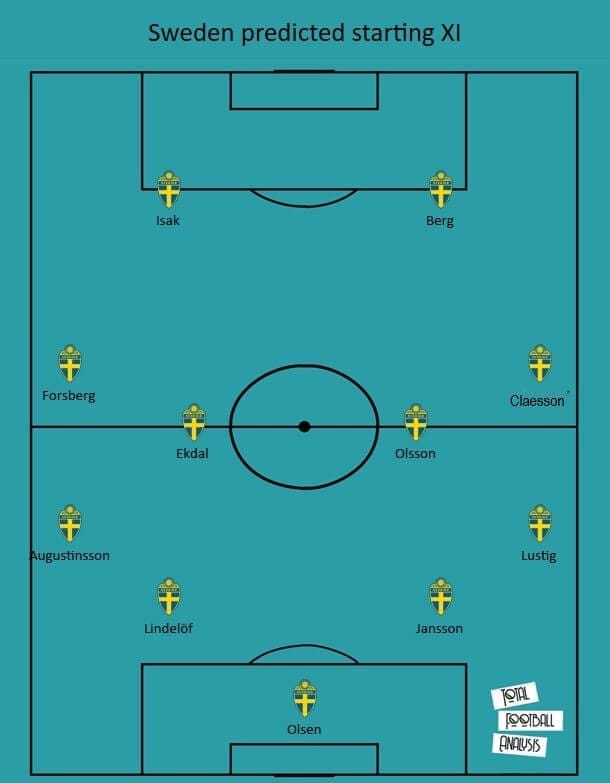
This is likely to be Sweden’s starting eleven for the bout against the winners of the competition in 1964, 2008, and 2012.
Everton’s Robin Olsen will be in goal for the Blue and Yellow. The 31-year-old has had little game-time this season but is still Sweden’s number one keeper. He will be protecting the net behind a back four of Ludwig Augustinsson, Manchester United’s Victor Lindelöf, Pontus Jansson, and Mikael Lustig.
The double-pivot in their 4-4-2 may be Albin Ekdal and Kristoffer Olsson although there is a huge possibility that former Sunderland man Seb Larsson starts instead of Ekdal. The midfield duo will be flanked by RB Leipzig’s Emil Forsberg and Viktor Claesson while the strike partnership up top will consist of Marcus Berg and Alexander Isak.
Zlatan Ibrahimovic would have been starting in this one although the Swedish legend pulled out of the tournament due to a knee injury he suffered in Milan’s 3-0 victory over the Bianconeri a few weeks ago.
Spain’s set-up in possession
Spain play exactly how one would expect them to under a former Barcelona coach. Their base formation is a 4-3-3 but it rarely stays like this throughout the different attacking phases of the game.
Spain, of course, like to play out from the back due to the nature of their positional play system. When they are in the build-up phase and the opposition is pressing them high, their shape looks more like a 4-2-1-3. The two centre-backs sit at the edge of the 6-yard box in line with the goalkeeper while the fullbacks also remain fairly low.
One of the advanced midfielders drops next to the single pivot to create a temporary double-pivot also.
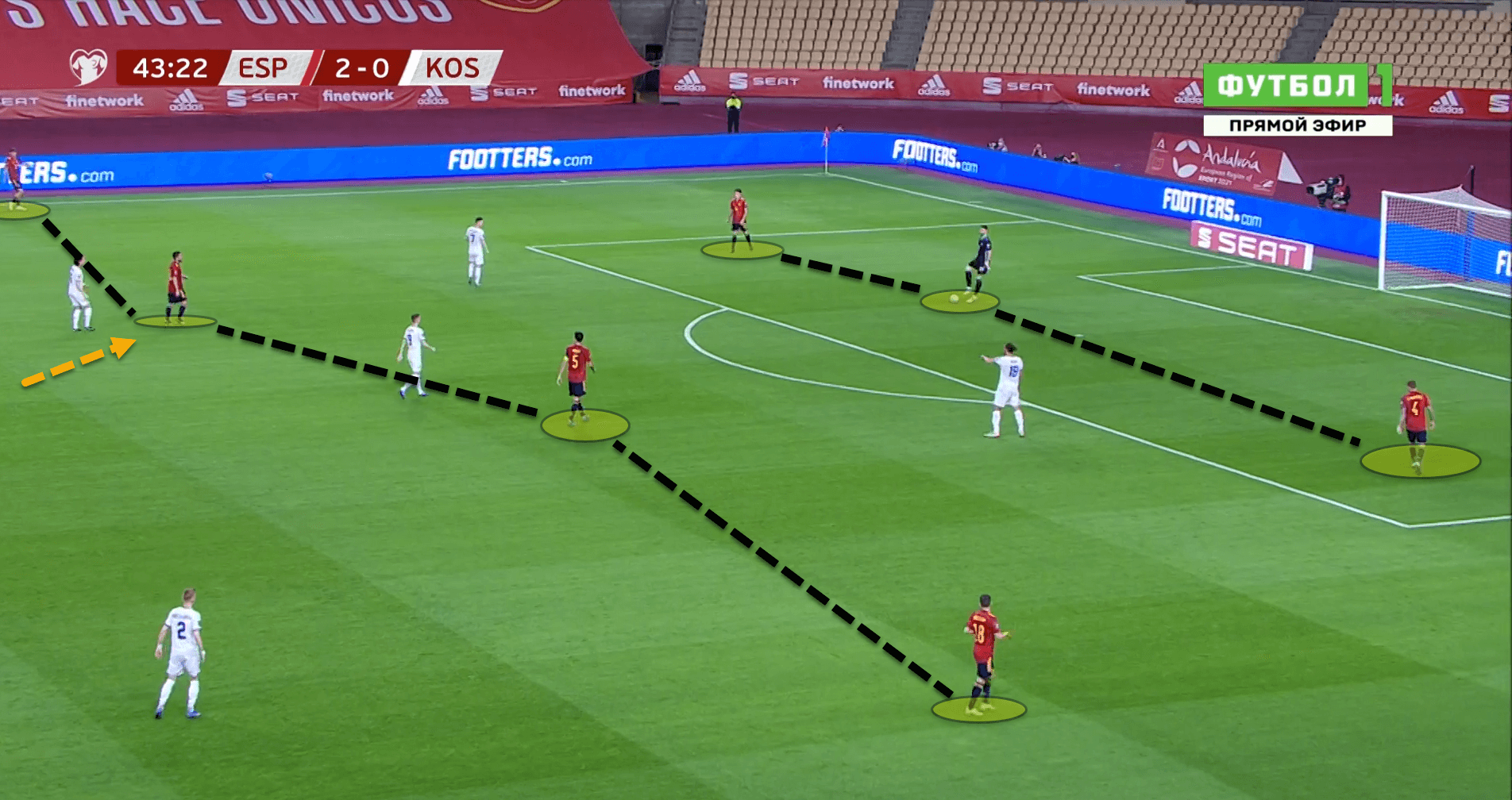
Here, Spain’s set-up in the build-up phase regarding their back four and two midfielders can be seen. The players create two different horizontal lines. On the first line, there is the centre-backs and goalkeeper, while the two midfielders and the fullbacks are together on the second line.
This set-up makes ball progression out of the first phase of the attack much easier as they have seven players in this area of the pitch, all at a close distance. Having a double-pivot also makes build-up play easier because when the ball is played from one flank and circulated back through to the other, there is always a pivot player at an adjacent distance to create a triangle with the centre-back and fullback.
Further up the pitch, Spain’s shape is slightly less structured but is very important to their ball progression.
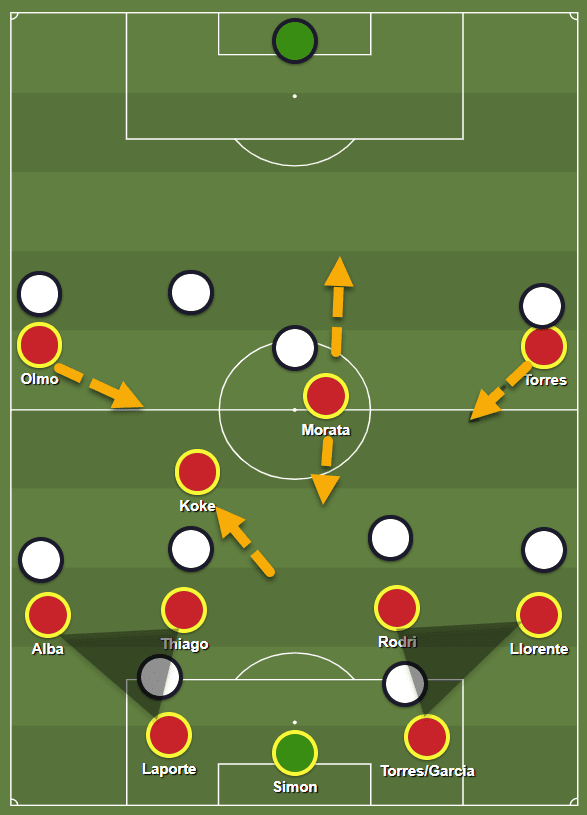
The two wide men tend to stick to the touchline which allows La Roja to stretch the opposition’s defensive block to create space centrally, although at times the wingers will drop into the halfspaces depending on the situation and their opponent’s positioning.
Playing Morata up top allows Spain to have a quick centre-forward to run in behind the defensive line but also because he is physically well-built and tall, the Juventus man can also drop short to win long balls and potentially flick them on.
Finally, the spare central midfielder tends to push up beyond the opposition’s midfield. This player has positional superiority between the lines as the opposition’s block is stretched both vertically and horizontally so they will have time on the ball to receive and pick out a forward pass.
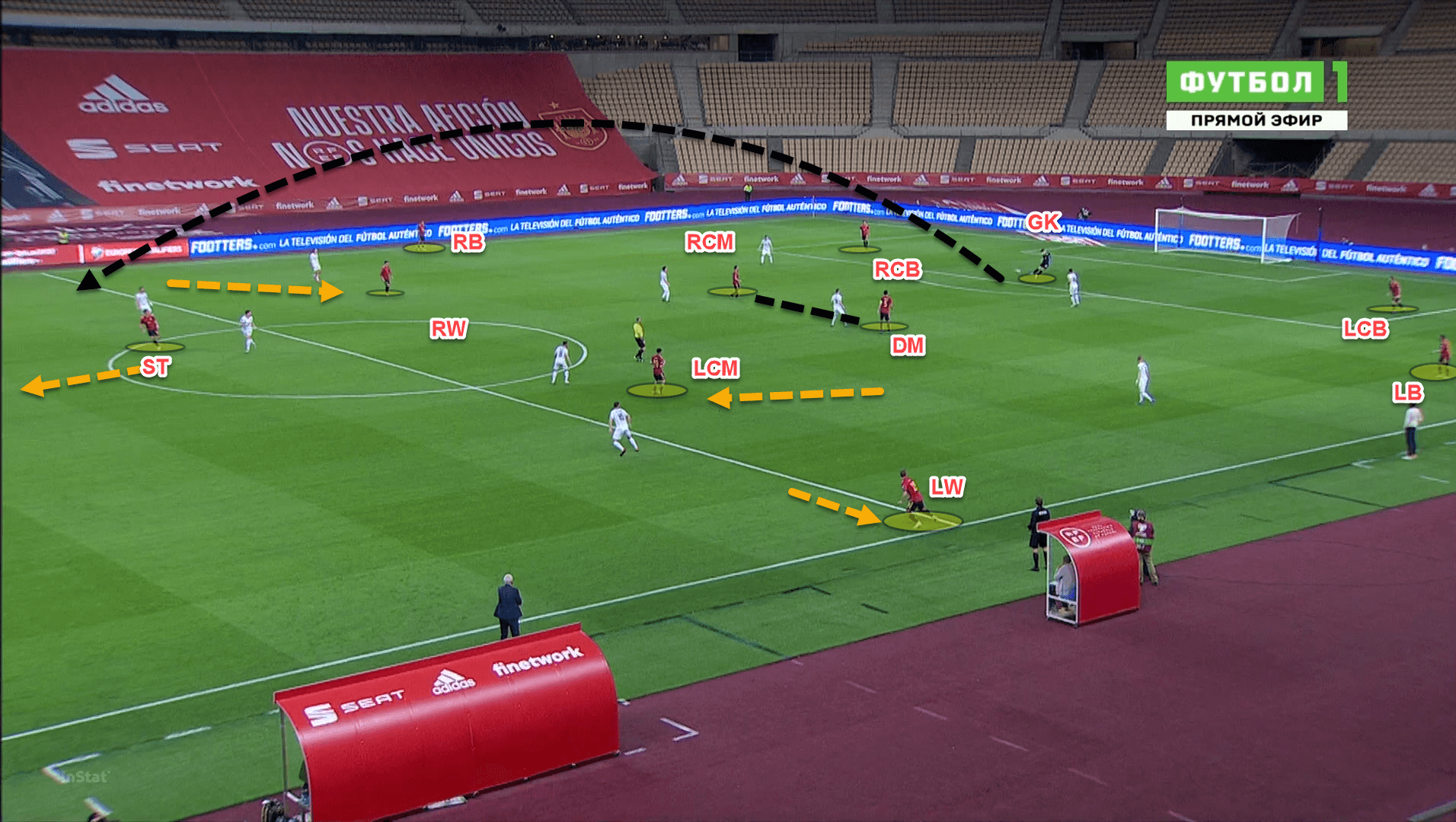
Spain’s build-up play can be very effective, and Anderson and his coaching will need to come with a defensive game-plan to prevent the Spaniards from being able to carve Sweden open in this phase of the game.
How can Sweden stifle their build-up play?
Whilst Sweden are quite comfortable in possession of the ball, it is very likely that they will be chasing the game for the majority of the ninety minutes. In the past two meetings between the two sides, Anderson was in charge of the Swedish national team, and Sweden averaged just 75 percent of the ball possession over two games.
A relatively conventional prediction would say that there will probably be a similar outcome in this match regarding ball possession.
Sweden have two options to stop stifle Spain’s build-up play. Either they don’t press high when the Spanish are in the build-up phase and instead opt to drop off and protect the space behind their backline, sitting in a deep block, or else they press Spain high and try to prevent them from progressing through the thirds as high up the pitch as possible in order to prevent them from being carved open further up the pitch.
Realistically, it will be the latter. Anderson wants his side to press high regardless of the opposition so on Monday, they will need to be as coordinated in their press as possible.
Sweden press in a man-oriented 4-4-2 and so it is likely that they will stick with this system with the role of the front four being very important. In a recent pre-tournament friendly, Finland used a similar build-up strategy to Spain and Sweden dealt with it quite well.
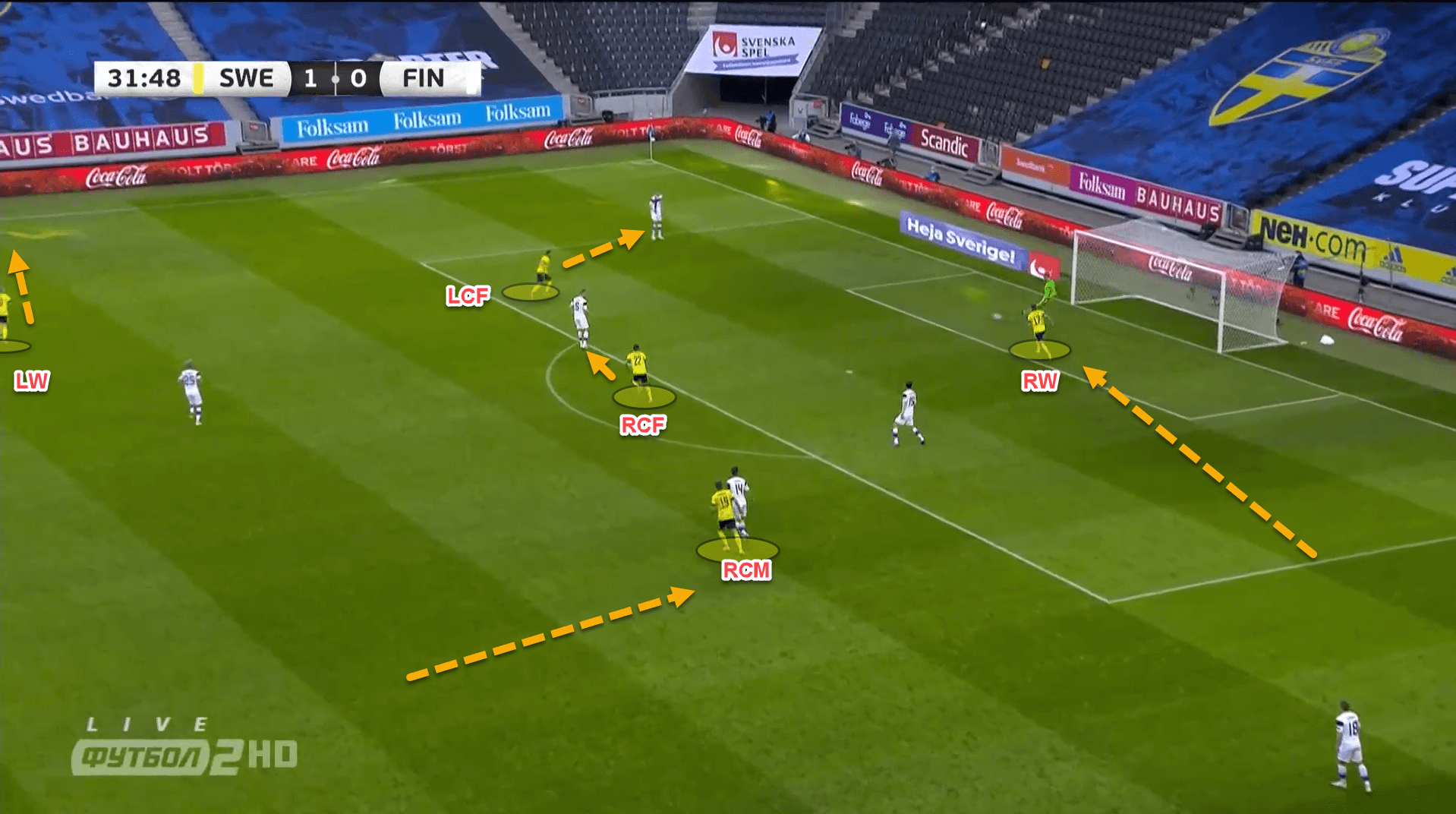
Against Finland’s back four with a double-pivot, Sweden pressed the right centre-back and goalkeeper with their right-winger, Viktor Claesson. This cut off any access to Finland’s left side.
The left centre-forward, Berg, pressed the left centre-back whilst the right centre-forward, Robin Quaison, marked Finland’s right pivot midfielder. Olsson, the right central midfielder pushed up high to mark his opposite number while Forsberg was tasked with pressing the fullback on his side.
The key for this entire system though was to force Finland into one side of the pitch using the ball-far winger, which completely cut off access to multiple passing options. From there, they could look to press easier in a smaller area of the field.
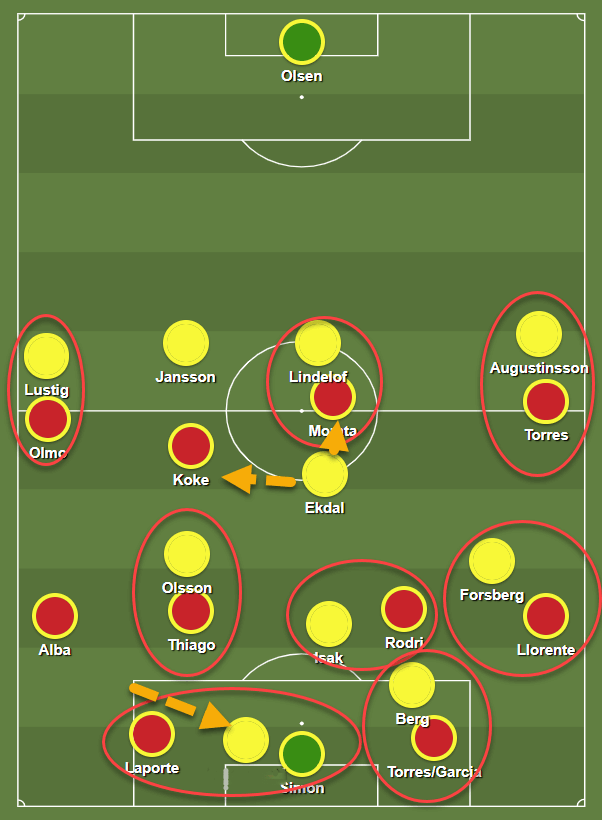
This is how Sweden’s setup could look against Spain’s build-up structure. As can be seen from the image, there is a lot of man-orientation happening in the high-block phase, however, what is also noticeable is that Ekdal is sitting deeper. The reason for this is to protect the backline from second balls from long passes. His role will be more zonal and will be responsible for picking up both Morata and Koke, depending on the situation.
Of course, no structure is guaranteed to work in football, and whilst this pressing system worked against Finland, they will need to be even more focused, intense, and coordinated against Spain as there are some incredibly talented players in the Spanish setup, capable of cutting through any pressing scheme.
How will both sides look to score?
Spain
When Spain are progression phase and looking to break into the opposition’s final third. They tend to do so through the wide areas, creating positional rotations in the halfspaces and on the flanks to create space to play through the opposition, particularly on the right side of the pitch. Against Sweden, this will be no different.
These positional rotations come from the fullback, wingers, and advanced central midfielders and they occur in two different forms. The rotation that Spain use the most seems to be when the ball-near advanced midfielder drops into the backline and allows the fullback to get forward on his side.
However, the fullback does not just move higher up as the winger is occupying the space on the flank. Instead, they push into the halfspace and attack the depth as well as look to receive the ball in space. This is only done on the right side as Marcos Llorente is capable of playing as a midfielder as opposed to Alba on the left and so this suits his play-style.
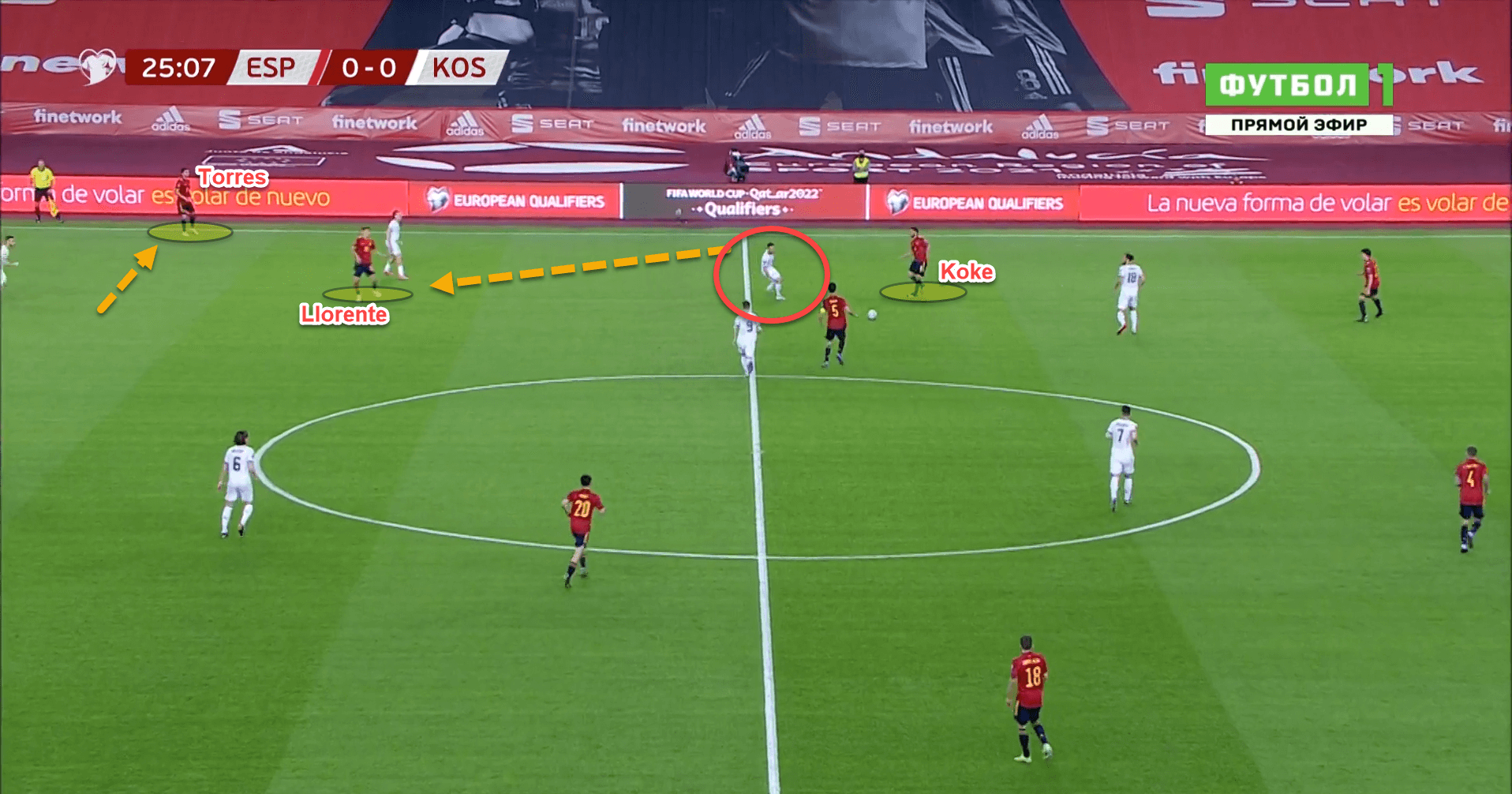
We can see this common positional rotation from the image above. Spain successfully progressed through Kosovo’s defensive mid-block using this in the example given.
Koke dropping deep into the space next to the centre-backs forced the left central midfielder in Kosovo’s 5-2-1-2 to push up and press him which left space in behind for Llorente to push into and receive the ball in a space from a third-man pass.
These positional rotations are a fantastic way of breaking down a defensive block when applied correctly and used to the team in possession’s advantage. Spain are well-drilled at them and so Sweden will need to ensure that they do not over-commit to pressing a player as it will leave massive space in behind them for the Spanish to exploit.
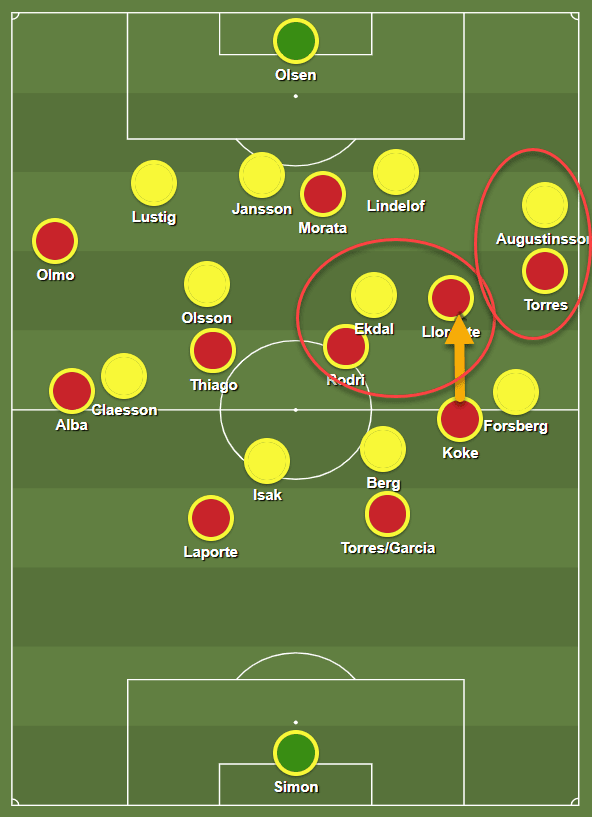
As can be seen from the diagram above, due to the nature of positional rotations, the opposition can be dragged out of position which leaves space to be exploited. In this scenario, since Llorente has positional superiority between the lines, if Koke can play the ball to his feet quickly, he will be able to turn and drive at the opposition’s backline and look to create an opportunity for the forwards.
Obviously, Sweden will need to ensure that they are compact so that when situations like this do arise, they always have defending players close by capable of covering.
Sweden
Sweden are a side who are very comfortable in possession, but they also like to get forward rather quickly, looking for a forward pass at all times.
When in a structured positional attack in the middle third of the pitch, also known as the progression phase, Sweden builds up with a back three. Their right-back, typically Lustig, stays back while the left-back ventures forward on the opposite flank.
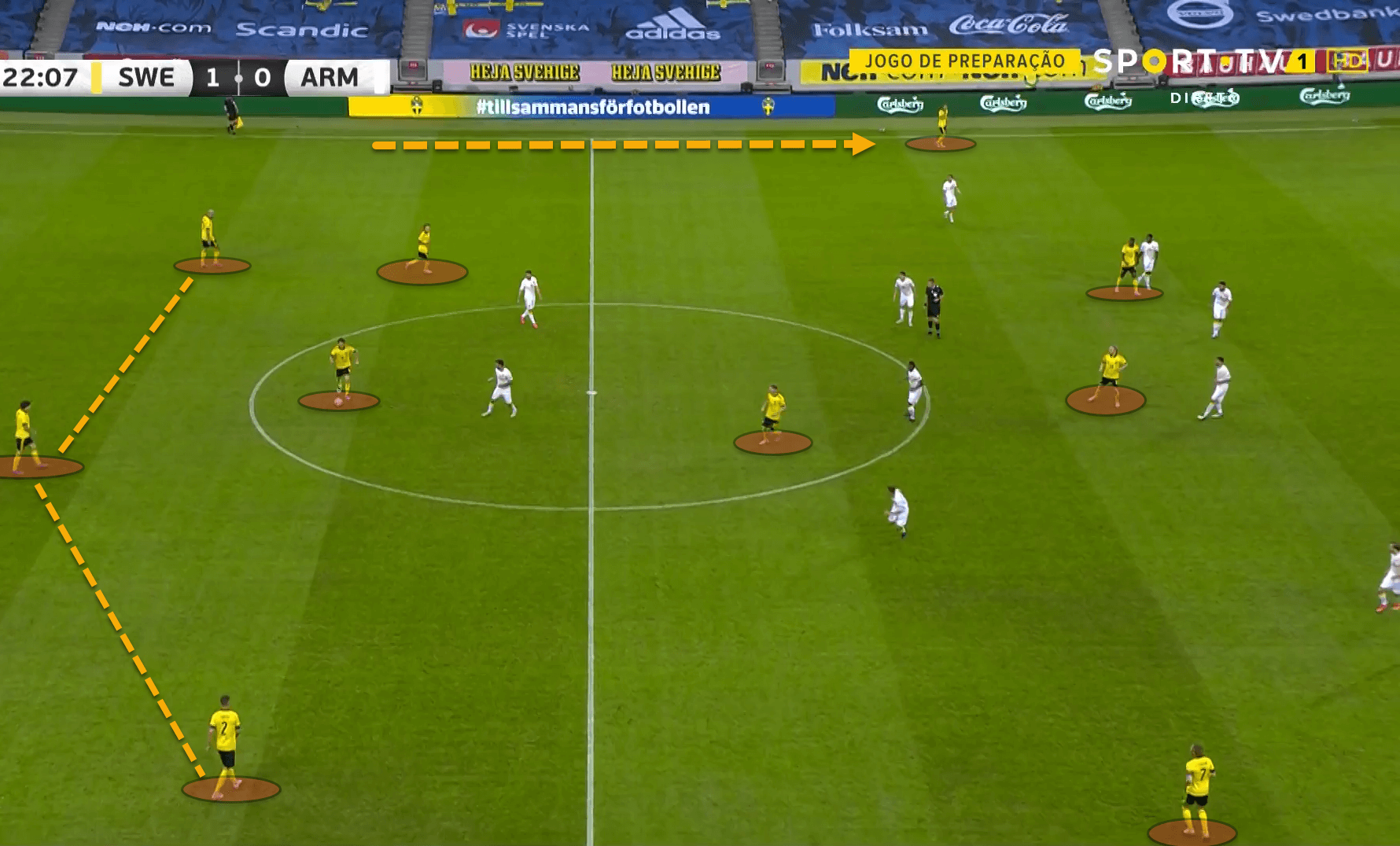
The width on the right side is kept by the right-winger who hugs the touchline, rarely drifting inside unless the situation forces him to. What is most important to Sweden’s quick and precise build-up play is that they have multiple players between the opposition’s line in the central corridors at all times.
In the image above, we can see that they have three players between the Armenian lines in the central areas, all of which are in good positions. The importance of this is that it allows them to have passing options through the lines to try and break down their opponent’s defensive block.
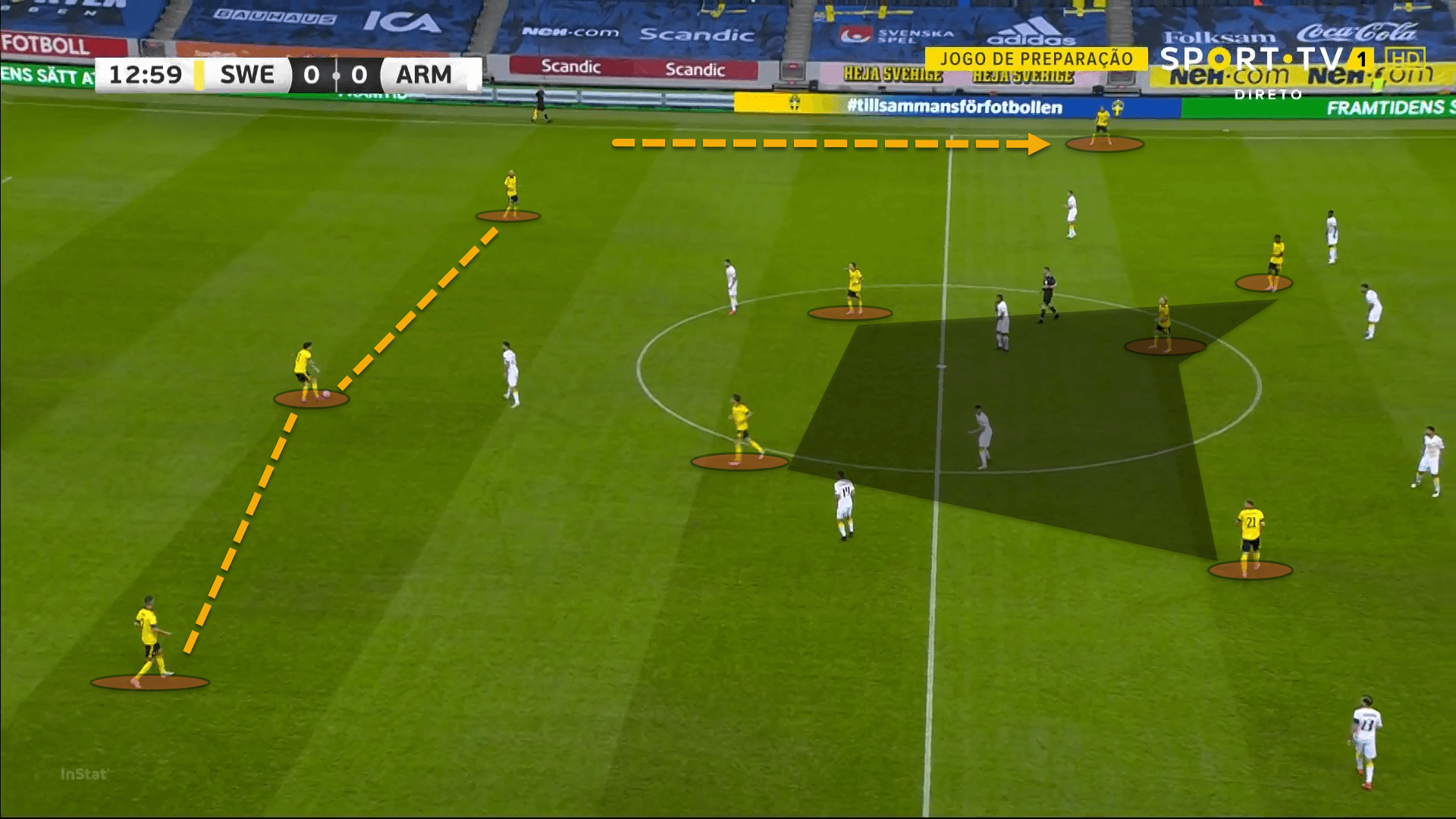
Here is an even better example of how their central players are positioned between the lines, constantly giving Sweden positional superiority against their opponent’s defensive block.
Sweden tend to be quite patient in patient when the ball is with the backline and they are circulating it around looking for a way through their opponent’s first line of pressure. However, when this first line is broken, they are instructed to play forward quickly, with players dropping short between the lines and others attacking the depth to create space.
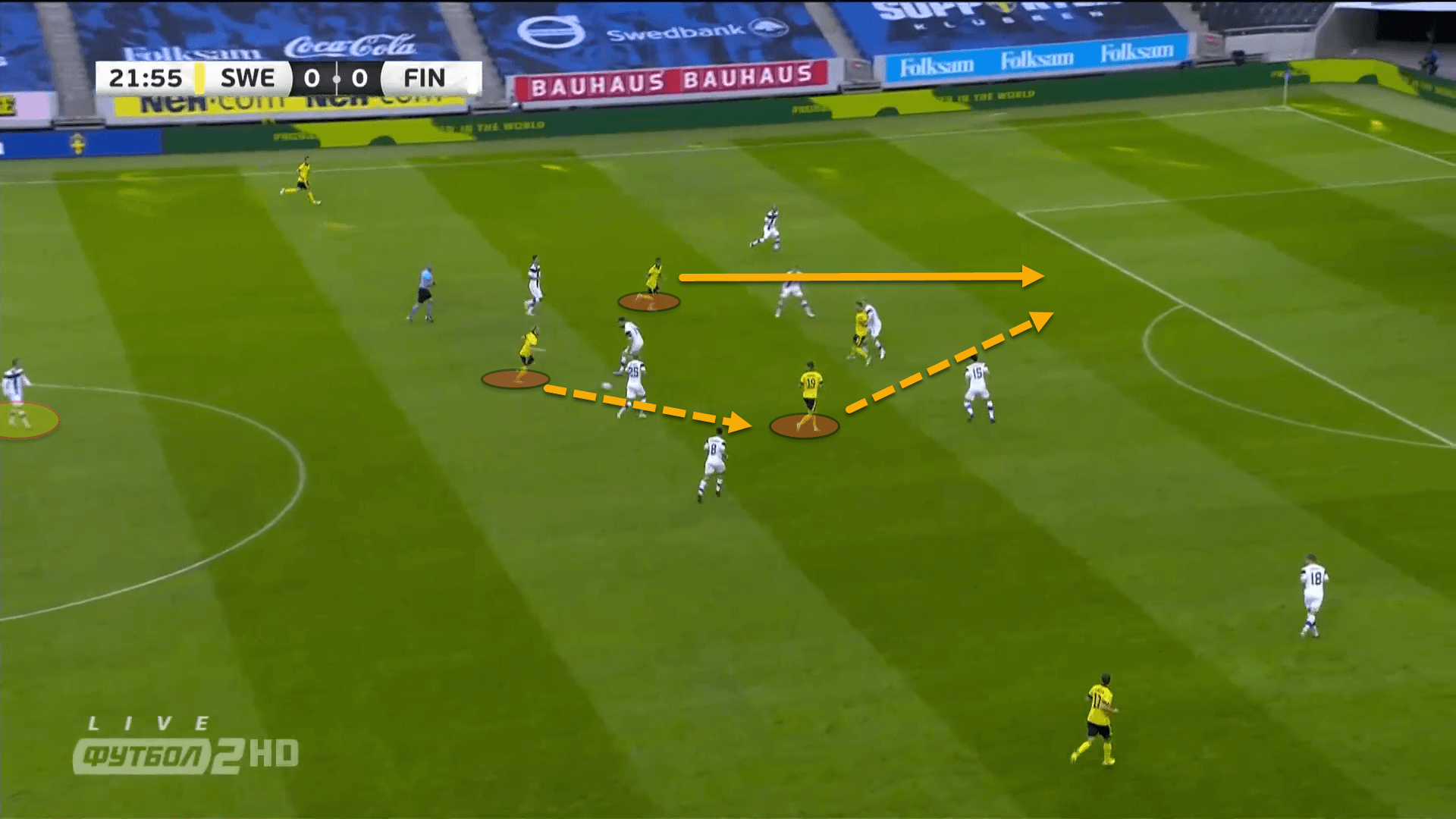
Here is an example of this quick and progressive play when Sweden break the opposition’s first line of pressure. When the ball eventually broke Finland’s first line, Sweden played two passes using a third-man run to get in behind their opponent’s backline and score.
Spain play a very high line, even defensively, and so they will need to be careful when the first line is broken as Sweden will look to carve them open almost instantly to get in on goal and score.
Conclusion
This is one of the most exciting games from the group phases of the European Championships this summer. Both sides are excellent footballing sides with fantastic tactical systems and superb players, so it is likely to be a spectacle.
Spain are certainly the favourites heading into Monday’s bout, but Sweden could surprise a few and pull off a major upset if they manage to nullify La Roja’s attack.






Comments